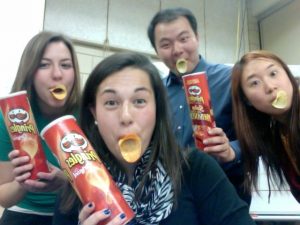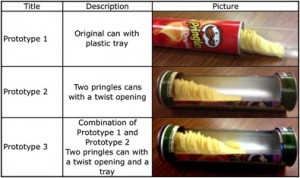Kellie McGrath learned about the importance of teamwork, something vital to practicing engineers, when she redesigned the Pringles chips can.

The project was for IE 576 Human Factors in Product Design, a graduate-level course that McGrath, a graduate teaching assistant of industrial and manufacturing systems engineering, says was big on team-based learning.
The course re-started this past spring semester after Michael Dorneich, associate professor of industrial and manufacturing systems engineering, and Rick Stone, assistant professor of industrial and manufacturing systems engineering, teamed up to develop a new approach for teaching it.
Dorneich says there are many theory and method classes in IMSE, so both professors wanted to make Human Factors in Product Design an applied learning class. They discussed different elements and factors each week and then applied them in projects.
These projects assigned students into teams to design and redesign products using concepts from engineering, psychology and physiology.
Before McGrath and her team could go to work on the Pringles chips can, they had to prove there was a problem with the can’s design.
They conducted three rounds of surveys and found the small container opening, which limited access, and broken chips were the two areas of concern for Pringles fans.
To address these issues, the group developed three different prototypes that kept the can’s original external design with a redesigned interior.
McGrath explained that her team didn’t enlarge the can for easier access because the extra space might cause more chips to break during processing and shipping. And they didn’t make the can smaller because consumer’s access to the chips would be even more limited.
One of the prototypes featured a sliding tray inside the can for the chips to sit on so consumers could slide the tray to access the chips.
The second featured a twist design that they created using two cans – “a can inside of a can”. When the can twisted one way, it was closed, but it opened when it was twisted the opposite direction.
“It was similar to the tray design, except the cans became the tray,” she explained.
The third prototype was a combination of the previous two, and it featured both the twist design and a sliding tray. After testing the prototypes, the group found there was a tradeoff between the designs.

“Where the twist was more difficult to understand initially, it became the preferred design once the test subjects understood it,” McGrath said.
The team’s ideas resolved certain issues, but the group had to consider whether the costs to implement the changes justified the benefits.
She explained that the Pringles can is designed also for easy manufacturing. Would spending more money to insert a tray into the can to make it easier to access the chips result in more people buying them?
Stone also noted they needed to consider that “good design means a product should be obvious and easy to use.”
Whether or not the new designs would be economically feasible, McGrath said the project ultimately taught her the value of teamwork.
“It was an incredible experience to see how the ideas we each contributed came together into a final product and report,” she said. “We all had roles that focused on our strengths, and we learned from each other to improve upon our weaknesses.”